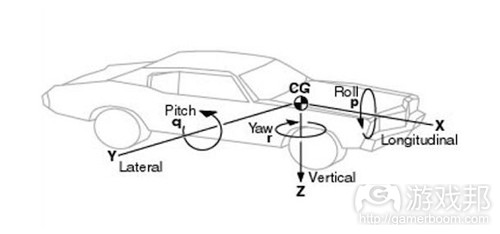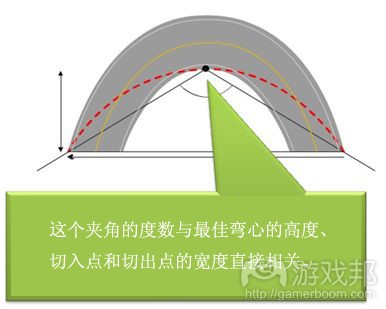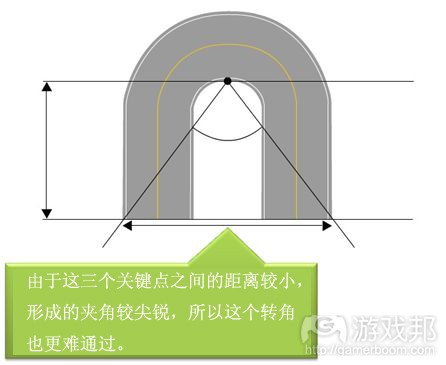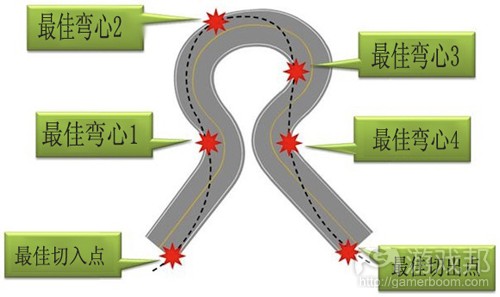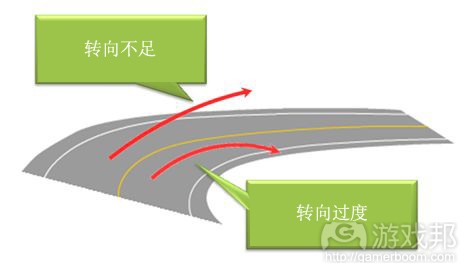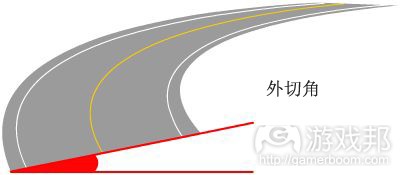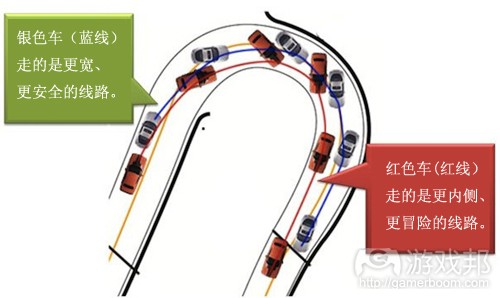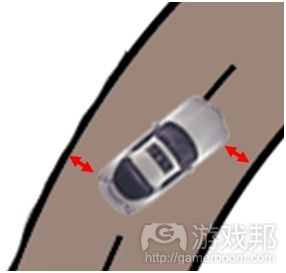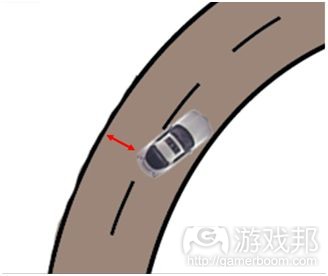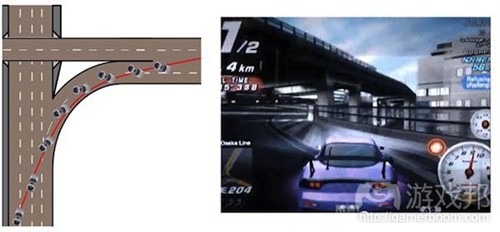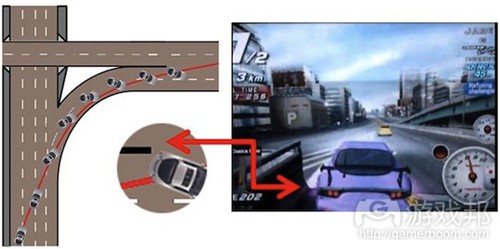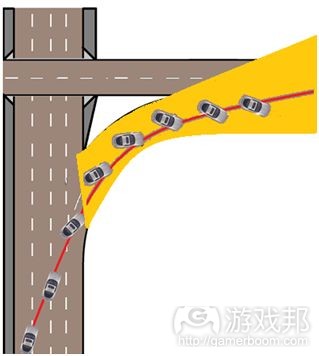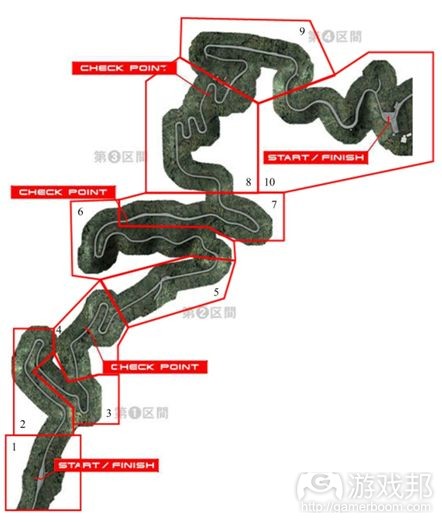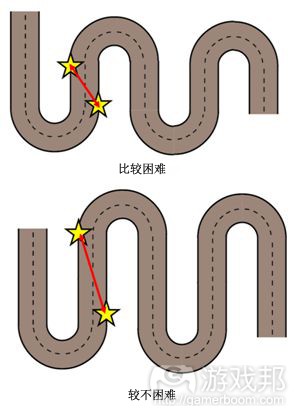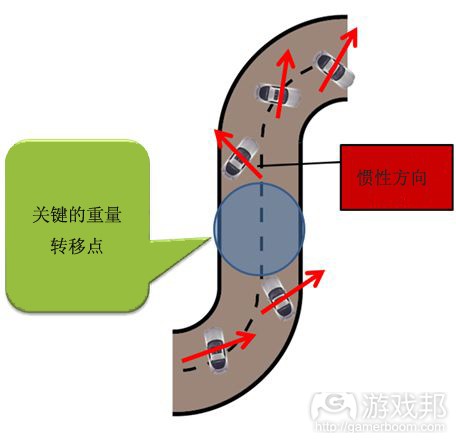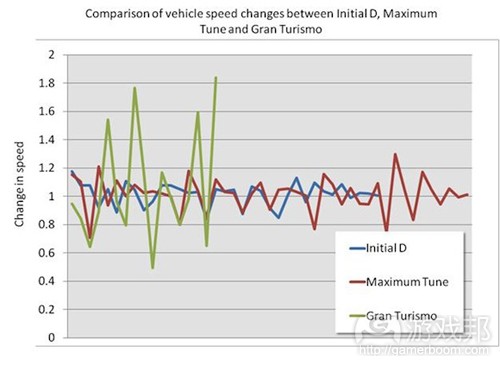实例分析赛车游戏的赛道设计原则
作者:Luke McMillan
(本文以《头文字D》、《Maximum Tune》和《GT赛车》为例,详述赛车游戏的跑道设计原则)。
游戏是一种“授权”模拟,即赋予玩家权利去完成或做到某些在现实生活通常(或合法情况下)不允许的事。赛车游戏,特别是冒险赛车游戏,就是绝佳例子。赛车游戏不要求玩家都达到驾驶F1的水平,否则99.9999%的玩家都只能靠边站了。
能不能在现实生活中玩赛车,资金是一个大问题——你不仅需要买一辆好车,还得支付所有与“合法”赛车相关的费用。除了资金,最难克服的阻碍就是年龄和许可证——多少未成年人想开快车,但现实不允许啊!
冒险赛车游戏运应而生。设计良好的赛车游戏不仅向非赛车手的玩家“授权”,更重要的是,给予其非凡的体验。
去过游戏机厅的人会发现,有两款游戏霸占了街机市场,其玩家通常不是赛车手,却开着马力超过820的车像怪物一样狂飙。
让业余玩家也能够自如地驾驶极限赛车的是两种东西:赛车动力系统和跑道设计。本文将着重讲解赛道设计的原则,并利用这些原则分析《头文字D4》中的秋名湖环道和《Maximum Tune 3》中的阪神快线。
五大基本指标
在讲解设计赛道的原则以前,我们有必要先了解一下跑道的五大基本指标,这是支撑赛道设计的基础,且适用于许多不同的场景。这五大指标如下:
1、赛车线路
2、弯心(弯道内侧顶点)
3、赛道宽度
4、夹角(车轮面与垂直面的夹角)
5、高度变量
接下来我将分别讲解以上指标。
弯心&赛车线路
在赛道设计中,最重要的指标是弯心和赛车线路。在理解两者的作用以前,我们先粗略地了解一下赛车及其动力系统。下图是汽车工程师学会(SAE)的汽车标准模型,所有赛车游戏都会用到图中的轴线。图1采用的是标准的SAE坐标系。
其中,纵轴线(Longitudinal)上的力直接影响赛车的加速和刹车。左右摇摆(Yaw)和横轴向(Lateral)的力对驾驶和重量转移的影响最大。在赛车游戏中,为了产生最大的速度,我们希望玩家尽可能地采用纵向力。而刹车和横向力不仅会使赛车减速,还会使赛力更难控制。把这两点记下了,我们就可以进一步了解弯心和赛车线路的概念了。
本文所提到的指标都是以对赛车的影响为基础,而不是对玩家的作用。赛道总是直接影响赛车,而对玩家的作用只是间接的。这是即使是在相同的赛道上驾驶不同的赛车,玩家的体验也总是不同的。
从某种意义上说,赛车是一种转换器,是玩家与赛道设计之间的必要中介。赛车的动力本身就是一个太广泛的主题,在此我就不多加讨论了。只看SAE标准轴线系统,我们就已经能够明白这五大指标是怎么回事了。
赛道上的所有转角都有一个最佳切入点、最佳弯心和最佳切出点。弯心是赛道边缘的一个目标点,如果玩家希望以最短的距离通过拐角,就务必通过这个点;同时,玩家还必须尽可能减少施加于赛车上的横向力。
在某些情况下,弯心就代表了通过拐角的最短路线,但这要求赛车承受更多的横向力。最佳弯心使玩家能够在使用更多的纵向力的同时,不必增加多余的横向运动。
通过分析转角的最短线路和最大化利用路面,可以确定切入点、切出点和弯心所在。路面区域为什么重要?原因是,如果路面够宽,玩家就可以少用横向力(游戏邦注:横向力总是影响加速和操作)。
我们再回头看图3,图中的绿线代表线路——或最者说是通过拐角的最佳线路。路面越宽,所需的横向力越少。总地来说,冒险赛车游戏的玩家总是找机会增加纵向力。
如果把这两条指标单独列出来讲,恐怕有困难,因为二者是互生关系。赛车手会根据自己对赛车和弯心的理解,在自己的脑中想象出一条赛车线路。而对于设计师,他们的头脑当中出现的可能是赛车线路也可能是赛道,这取决于设计的方法。
无论设计师采用什么方式设计赛道,理想的赛车线路都应该至少保证赛车受到横向力的影响。
图4表示的是一条简单的赛道曲线。根据这条曲线,设计师还需要考虑弯心位置、然后制作正式赛道。而图5表示的是另一种相反的赛道设计方法。设计师先计划弯心,然后决定理想线路。无论采用哪种方法,结果都是如图6所示的小型赛车风格的布局。
从图6中,我们大抵能看出最终赛道的样子,但这绝不代表有了以上知识我们就能够设计出理想的赛道了。接下来还要处理转角的难度。转角的难度由赛车线路和弯心共同决定。
切入点、弯心和切出点这三者构成的夹角越小或三者之间的距离越短,转角的难度越大。请对比图7和图8。
大转角可以同时拥有数个弯心,但切入点和切出点却总是各有一个。玩家必须把切入点和切出点当作一个记住赛圈的“标点”。
进一步地说,通过这种方法,赛道设计师可以想出一个组合了直段赛道和转角和赛圈。
根据所使用的赛车动力系统的类型,直段和转角相组合有利于实现游戏的平衡,即给予不同属性的赛车以相同的赶超机会。
具有多个弯心的转角叫作“复合转角”(如图9所示)。确定复合转角的转角的方法也相似,即弯心之间的距离越短或校正线路的可用路面(由三点之间的夹角可推断)越小,难度越大。
请务必注意,不同的赛车游戏会有不同类型的赛车动力,这会极大地影响使用弯心的方法——这部分内容将在分析案例时详述。
理解弯心及其对赛车线路的影响是赛道设计中最困难的部分。难怪赛车游戏这么让人伤脑筋了。
我这么说的意思是,玩家必须以最少的操作量、刹车和加速动作来解决空间问题。我们已经讨论过赛车的动力,游戏中采用的动力系统的类型会严重影响设计师对弯心和线路的设计。
赛道宽度
赛道宽度是一个比较常识性的指标,相对容易理解和执行。根据经验,路面越宽,转角的难度越小,因为弯心之间的夹角更大,赛道的整体难度也降低了(可返回看图3)。
一个被普遍承认的设计原则是,在第三人称游戏中,场景应该按大约33%的比例放大。所以,赛车游戏及其赛道亦是如此。原因是,这样做可以给镜头腾出移动空间,同时给予玩家赶超对手的时机。
设计赛道的规模时,每条车道的宽度应该是赛车的1.6倍,这样才能2条车道就能容纳3辆车并行,同时保持分离的距离最小(如图10所示)。此外,路肩的宽应该保持在赛车的50%至75%(如图11所示)。
如此设计,玩家就可以冒险争取战略上的有利位置——特别是在转角时,横向力会影响赛车的质量,从而阻碍玩家向有利位置转移。赛道的截面越宽,犯错的可能越大。转角越钝,有经验的玩家就能运用更多的纵向力,从而使线路行驶更加顺畅。
夹角
路面夹角与路面的倾斜有关,还会影响滚动倾侧角(影响赛车拐弯的能力,即过度转向和转向不足,如图12所示)。所谓“过度转向”与“转向不足”是描述赛车的动力的术语,而“内夹角”和“外夹角”则与赛道的设计有关(如图13所示)。
电子游戏《Daytona USA》大量使用内夹角转向,这个闻名的设计实现了不可能的转角切入点和切出点速度,这样,业余玩家只需要一点点操作就能完成高难度的转角。另一方面,像《GT赛车》这种更贴近现实的游戏会综合运用内夹角和外夹角,以测试玩家和他们所选择的赛车的极限。这种模式基本上需要玩家进行大量练习实践,所以不太适合游戏厅环境。
理想地说,所有街机风格的赛车游戏中的转角都应该是内夹角,因为这样才能在游戏中加入一些大胆又冒险的转弯。因为赛车游戏所吸引的特定玩家群体,这个考虑是比较合理的。
高度变量
高度变量在赛道设计中有两个突出目的。第一是,创造一种非对称的平衡,即赛道对一种赛车有利,对另一种赛车不利;第二个是,让玩家产生紧张、放松的情绪,和让玩家有机会“展望未来”。第二个目的本身就是一个主题,我在以前的文章中已经详细地探讨过了。简要地总结这两个目的,前者可以这样理解,因为各种赛车的不同质量和动力,高度变量对玩家可能有利也可能有弊。
一般来说,我们可以把后者当作是赛道设计和关卡设计中的纯情绪成分。视线限制会让玩家产生焦虑感,因为他们不能估计前面的路况。当视线延长时,玩家会感到自己更有能力,因为他们能够轻易地预测下一步行动。
从情绪的角度来看,只要合理地使用,高度变量就能给赛道增加乐趣。高度变量还可以给玩家带来“展望时刻”,从而给环境和体验增加额外的兴奋点。
这些展望时刻通常在玩家上坡时强行限制玩家的视线一段时间。
一旦玩家达到稳定水平,开始下坡时,他们的视线就比上山时增加了许多,这样他们就能看到赛圈的全景和关卡设计。
综合指标
既然我们已经理解了以上五大指标,现在我们可以将其运用到案例研究了。不过,因为赛车的动力系统所起的作用太大了,所以有必要先区分《头文字D》和《Maximum Tune 》这两款游戏中各自使用的赛车动力。前者使用了一个叫作“赛道线路惩罚”的系统,后者以“Scandinavian Flick”为驾驶特色。
Scandinavian Flick
图14是Scandinavian Flick的模式图。玩家通过最佳切入点后转向最佳弯心。
一旦赛车的重量开始向这个点转移,玩家就可以逆转舵,驶向最佳切出点,最终克服赛车的惯性,在不同的点之间实现赛车质量的转移。在这一过程中,玩家要兼顾纵向力、横向力和左右摇摆。Scandinavian Flick有别于其他纯粹“抓地”式的驾驶的特点在于,过度使用纵向力。
我在文章前半部分提过,横向力起的是消极作用。然而,《Maximum Tune》的赛车动力偏就设计成了不得不用上小部分横向力才能跑出理想线路。
在《Maximum Tune》中,赛车在转向中速度会减少,但通过逆转舵可恢复。这意味着,玩家得在逆转舵上花更多的时间——结果,在这款游戏中通过转角的弯心,不足50%能称得上最佳。
这就是《Maximum Tune》处理横向力的方法之一。把弯心位置提前意味着大多数时候,过转角时使用的纵向力比横向力多。至于如何把弯心位置提前,那就是让转角切出点比切入点宽。
错失弯心
《Maximum Tune 》和《头文字D》都将错失弯心作为惩罚玩家的方法和赶超对手的时机。图15表现的是一名玩家错失最佳弯心。为了保持赛车线路(影响了过转角的最大速度),玩家必须进一步调整,这样就牺牲了赛车的速度。
一旦赛车运动起来,玩家就不喜欢被意料之外的力量所干扰。然而每校正一次,就有一股意料之外的力施加到赛车上,这样就导致了赛车的减速和不稳定。在所有赛车游戏中,玩家总是希望得到比较高的转角切出速度。研究后面的案例时我将进一步拓展这个话题。
线路式惩罚
《头文字D》采用的赛车动力系统组合了擅长打滑和抓地的赛车的特点,这样就在赛车之间产生了一种非对称关系——赛车不需要造形上的对称,因为玩家和赛道的组合关系总是会产生不对称性。
有些人可能更倾向于使用Scandinavian Flick,而另一些人更偏向纯粹的刹车、线路式赛车、采用最有效的线路过转角。这种非对称关系决定了《头文字D》的主要机制就是线路式惩罚。
图16反映了两辆赛车通过相同转角的模式图。银色赛车走的是一条相对安全的线路,但这么做也更容易被超车,不过看结果,这条线路还是比较有效的。而红色赛车则撞上最佳弯心,从而获得更高的转角切出速度。根据赛车的CX值(游戏邦注:测量赛车发生碰撞时承受的能量值),红色赛车在《头文字D》中比较有优势,因为它的质量足以将银色赛车挤出最佳线路。
在这两款游戏中,玩家都需要权衡过转角的方法。图17表现的是玩家采取比较安全的过转角策略,从而为调整赛车的两边腾出更大的空间。尽管这么做比较不容易撞上路面上的护栏(撞上了就势必影响速度),但也损害了线路的效力,导致在最佳线路上被超越。
如图18所示,选择风险最大的过转角线路,玩家如能切中最佳弯心,则获利最大,否则失利也最大(因为没有足够的校正空间)。
一般来说,在游戏中,如果赛车相撞,被施加的惯力不如撞上路障的大。也就是说,宁可撞上其他赛车也别撞上路障,若是撞上其他车,玩家基本上还是有能力让赛车保持较高的稳定性。赛车稳定了,加速也更快,过转角也自然更顺利,因为没有其他力对赛车的动力系统产生影响。
《头文字D》vs. 《Maximum Tune》
到目前为止,我们已经知道了这两款游戏分别采用了不同的赛力动力系统和赛道设计。然而,对于非赛车手的玩家而言,二者都能带给玩家非常high的体验。玩家玩这两游戏的具体体验和情绪感受会有所不同,但通过分析二者的赛道设计案例,我们可以总结出一些实用的设计原则。
《Maximum Tune》的赛道设计及赛车动力系统的特征:
赛道较宽,采用四人制比赛
速度更快,转角比较缓和
游戏过程中有NPC赛车参与
领先的玩家可以采取不同的线路
棘手的转向比较少
《头文字D》的赛道设计及赛车动力系统的特征:
联网二人制比赛,对手为AI或其他玩家,强调对手竞争
狭窄赛道上的赛车速度较慢
线路性惩罚
无交通障碍
《Maximum Tune 3》之阪神快线
阪神快线是《Maximum Tune 3》中一条受欢迎的赛道,在设计上与《Daytona USA》中赛道有许多相似之处,特别是起点线圈。这条线路比较宽,有许多完全内夹角的转角。正如《头文字D》中的秋名湖环道,阪神快线是现实快车道(位于日本大阪)的美化版。
因为《Maximum Tune》的场景引用自日本系列漫画《Wangan Midnight》的非法高速赛车,所以本作强调高速穿过正常车流时的紧张快感。
前面提到,《Maximum Tune》将其最佳弯心位置移前,因此玩家可以获得更大的出转角速度,而实现的方法就是让切出口比切入口更宽。从情绪的角度看,这听起来可能有些无聊。然而,本作的设计师又想出了更高明的点子来美化玩家的活动,让玩家的感觉比事实上更好。这就是“针线”理论。
《Maximum Tune》之针线理论
阪神快线就是一个针线理论的缩影版。简而言之,所谓的“针线转角”就是由一个非常宽的切入点、一个弯心(只有一个)和一个“感觉上”非常狭窄的切出点组成的。(图19)
针线转角在激发玩家的情绪上意义重大,往往让玩家在成功通过转角后产生一种掌握的快感。与游戏中的其他元素一样,针线转角为的就是展现玩家看起来比实际上更好的一面,特别是在游戏机厅那种时不时有人过来瞄一下的环境。
图20揭露了这种撑握感和成就感的真相。当玩家正确地碰上最佳转角切入点时,赛车仍然偏向一边地驶过“针线”点,这样赛车就离路障更接近了。镜头的定位是有目的的,可以准确地捕捉这个不可思议的一瞬间——在现实生活中,这往往导致灾难,特别是按游戏赛车的速度行驶时。
在采用针线转角时,原设计可以先忽略狭窄的切出点。看图20,移掉路障,我们就可以看穿这个设计的方法学。在图21中,你可以发现,转角的切出点显著地比切入点来得宽,这意味着最佳弯心可以比转角来得早。路障的造成的另一个幻觉是,玩家需要美化自己的活动,需要让自己觉得无所不能。
《头文字D》之非对称平衡
《头文字D》采用的是多重赛车动力系统,这意味着要在实现平衡的同时给予玩家非凡的体验,赛道设计尤其重要。秋名湖赛道是现实的秋名湖公路(位于日本群马县)的美化版。图22是该赛圈的平面图。尽管两端都可以作为该赛道的起点,但通常把起点线设在海拔最高的那个扇区,然后往下依次通过十个扇区。
玩家一开始所选择的赛车类型会极大地影响其最适合赛道类型。
重型车如Nissan GTR在上山方面比较有优势,因为马力比较大。小型车如本田AE86则更擅长下山,因为质量轻,且能够在转角切出时执行转向过度。
秋名湖环道综合利用转角,巧妙地实现了玩法和逼迫对手之间的平衡。秋名湖环道在第八扇区采用独特的水平扇区。如果你对本作熟悉,你应该知道如图23所示的三个连贯的转角。
路标对速度感觉的作用极大,下面的图片标示了这些路标,用来表现其向玩家传递的紧迫感。
在对这个特别的转角做出解释以前,有许多指标要考虑到。在《头文字D》(以及大多数其他赛车游戏),角度递减的复合转角对轻型赛车更有利,而遇上角度递增的复合转角时,重型、大马力的赛车更具优势。(如图24和25所示)
还有一个复合转角的组成部分应该考虑到,那就是弯心之间的校正距离。在很大程度上,这个难度指标可以用弯心指标中的角度外推法来解释。然而,图26表明,难度指示与弯心之间的距离有关。
这些校正点之间的距离为什么这么重要?这是因为赛车动力和牛顿第一定律——匀速运动中的物体将保持运动状态不变除非受到外力作用。图27结合了赛车动力、弯心之间的距离和牛顿第一定律。《头文字D》中采用的重量转移对不同的赛车所起的作用也不同。
《ID4》 vs. 《MT3》 vs. 《GT5》之直道的运用
我们目前还没谈到的就是直道的运用。无论是什么形式的赛车,直道都是必须的,但是如果直道太长了,就会对非赛车手的玩家产生消极影响。
第一眼看来,直道好像很有趣:在直道上,玩家想怎么开风门都行。如果直道用得不好,特别是在街机游戏中,大问题就来了。现实中的直道运用和街机游戏中的直道运用,要搞清二者之间的差别,有必要先分析这三款游戏的统计曲线图。
以上三条曲线代表有经验的玩家分别操作大功率赛车跑《MT3》中的阪神快线、《ID4》中的秋明湖环道和《GT5》中的试验山。《MT3》和《ID4》均存在最低标准差,而《GT5》的最快速度和最慢速度之间存在最高的偏差。
图中记录了赛车在5秒间隔内的速度,比较了当前速度样本和最后一个样本。1表示赛车自最后一个样本起没有改变速度。正值表示速度增加,负值表示速度减少。
这个图表从更现实的角度反映了赛车游戏,如《GT》,直道可以让赛车获得的速度远远大于最佳转角切入速度,这就要求玩家在进入转角切入点时,必须经过一段刹车的时间。一方面迫使玩家必须学习这个过程,另一方面增加了赛道设计的困难。
掌机和电脑游戏在难度方面有特权。在掌机上,业余玩家每次玩都不花钱,因此在练习和识记方面多花时间也不成问题——犯错也不怕,另外,玩家连机对战时可以自己挑选时间。
街机游戏却必须照顾玩家的情绪,因为玩家每次玩都是在别人的眼皮底下进行的。尽管直道在所有形式的赛道设计中都有所运用,但为了业余玩家也能过瘾,直道绝不能让赛车的速度大大高过转角切入点的速度。因为直道会让转角难度增大,所以在这个棘手的转角出现以前,应该有许多更简单的转角作为过渡,以便玩家提前消耗过快的速度。
总结
本文的初衷是,探讨用什么方式让非赛车手玩家获得过瘾的赛车体验。《头文字D》和《Maximum Tune》都是非常优秀的游戏范例。通过对二者的分析,我们可以在五大基本指标的基础上归纳出以下原则:
1、在运用直道时,必须保证赛车的速度不超过最佳转角切入点速度。尽可能保证少用刹车。
2、转角必须渐渐缩紧,以确保玩家能够接近最佳转角切入点。
3、赛车速度的标准差应该相当小,理想值是保持在在+0.3或-0.3的范围以内。
4、用路标来制造速度感,这是必须的。
5、针线转角应该用来彰显美化玩家的技术。
6、街机赛车游戏的所有转角都应该是内夹角式的。
7、高度变量应该总是运用到赛道设计中,给玩家带来多样的情绪感受。但高度上的速度改变应该禁止。
8、用直线作为“标点”。用路标或标志性特征区分转角。
还有其他实用的元素比为本文力所不及。我们应该清楚地区分实际上的难度和感观上的难度。比较一下《头文字D》和《GT》中的速度改变,前者非常擅长给玩家制造感观上的难度,但在赛道设计上不如后者出彩。
此外,另一个要处理的大问题是赛车的动力。请务必注意到,不同的赛车动力并不会损害五大指标,相反地,赛车会给玩家带来相当不同的体验,特别是在制造难度方面。(本文为游戏邦/gamerboom.com编译,拒绝任何不保留版权的转载,如需转载请联系:游戏邦)
A Rational Approach To Racing Game Track Design
by Luke McMillan
[In this extensive article, Gamasutra takes an in-depth look at racing game track design, comparing two arcade titles -- Initial D and Maximum Tune -- and contrasting them, at important points, against the approach used in the Gran Turismo series.]
Games are about empowerment — being able to achieve and do things that you can’t ordinarily (or legally) achieve in real life. Car racing games, especially arcade racing games, are the perfect example of this. Reaching the level of skill required to drive in F1 will be out of reach of 99.9999 percent of the population.
Financial overhead also plays a significant role in being able to drive your car on a race track in real life — not only do you need a competent car, but you also need to pay all of the fees associated with “legal” racing. The most prohibitive factor though is age and licensing laws — every teenage boy wants to drive a high-powered car, but that just isn’t going to happen in reality.
This is where the humble arcade racer comes in. A well-designed arcade racer gives non-drivers an empowering, and most importantly, accessible experience.
But how do game designers make driving “on the limit” accessible, fun, and most importantly, empowering for non-drivers? The answer to this lies in analyzing the track design of two contemporary arcade hits: Initial D: Arcade Stage and Maximum Tune.
Anyone who has visited an arcade recently would have noticed that these two games dominate the arcade market, and are nearly always played by non-drivers piloting 820-plus horsepower monsters like pros.
There are two sides to this sudden and god-like ability for non-drivers to handle these uber-cars: vehicle dynamics and track design. This article focuses on establishing a set of rational metrics for track design and then applying these metrics to the analysis of the Mt. Akina track from Initial D: Arcade Stage 4 and the Hanshin Express Line from Maximum Tune 3.
Five Essential Metrics
In order to take a rational approach to track design, it is essential that we have a set of metrics. These metrics underpin all elements of track design and can be employed in a number of different scenarios. The five metrics of rational track design are;
Metric 1: Race Line
Metric 2: Clipping points (and related metrics)
Metric 3: Track Width
Metric 4: Camber
Metric 5: Height Variation
Before analyzing how the case studies provide an empowering experience for non-drivers, it is essential that that these metrics are explained both individually and in relation to each other.
Clipping Points & The Race Line
The most essential metrics for rational track design are clipping point and the race line. However, to understand how these two metrics work, it is important to talk about the vehicle and its system of dynamics. Using the existing Society of Automotive Engineers’ standard model, a vehicle has a pre-defined set of axes which are used in all racing games. Figure 1 is an example of the standardized SAE coordinate system.
The longitudinal axis is most directly affected by acceleration and braking. The yaw and lateral axis is most directly impacted by steering and subsequent weight transition. In a racing game, we want the player to apply as much longitudinal force as possible, as this will always result in a high speed. Application of brakes and lateral force will not only slow the vehicle down but also make it less predictable. With this in mind, we can now move onto the concept of clipping points and race line.
The metrics presented in this article are all based on the effect on the vehicle, not the end user. The track will always directly impact the vehicle, but only indirectly impact the driver. The reason for this is due to the fact that driving different vehicles on the exact same road will yield different experiences for the end user.
The vehicle is a translator of sorts, and is the essential middle man between the player and the track design. As vehicle dynamics is such a broad topic in itself, it will be discussed a future article, however the SAE standard axis system is comprehensive enough to be able to understand and apply the five metrics of rational track design.
Metric 1 and 2: Clipping Points & The Race Line
Figure 2
Every corner in a race track will have an ideal entry point, an ideal clipping point, and then an ideal exit point. The clipping point is a target on the roads edge that the player must aim for in order to maximize the chances of taking the shortest possible route through a corner, whilst at the same time placing the least amount of lateral force onto the vehicle (Figure 1).
In some cases, a clipping point might represent the shortest possible route through a corner; however, it may require the use of too much lateral force on the vehicle. These ideal points enable the player to apply as much longitudinal force onto the vehicle as possible (acceleration) without compromising this force with the addition of any unnecessary lateral movement.
Entry, exit, and clipping points are derived partly from creating the shortest possible route through a corner and also from using the most surface area of the road. The reason surface area is important is, if a road is wider, it means that less lateral force needs to be applied to the vehicle (remembering that lateral forces compromise acceleration and also make the car less predictable).
Jumping ahead slightly, Figure 3 has a dotted green line used to denote the race line — or most optimal route through the corner. The wider the road is, the straighter the race line becomes and less speed-compromising lateral force needs to be applied. In all cases, opportunities to increase longitudinal force are most sought after by players in any arcade racer.
It is difficult to talk about these two metrics in isolation, as they are a product of each other. For a driver, they will create a race line in their mind based on an understanding of their vehicle and the clipping points. From a designer’s perspective, the race line may supersede the track layout depending on the approach taken.
No matter what approach of these approaches is used in the design of tracks, the ideal race line should result in the least amount of lateral force being applied on the vehicle. To demonstrate these two approaches, we can refer to figures Figure 4 and Figure 5 respectively.
Figure 4 is the end result of drawing a simple spline to represent your track. Based on this approach, the designer would need to plan their clipping points then create the track around this. Figure 5, on the other hand, is just as valid, and uses the opposite approach. The designer would need to draw on the clipping points, then create the ideal race line. No matter what approach is used, the end result is represented in Figure 6 as a very basic, kart-style layout.
Although this is indicative of an end result, by no means does it represent the body of knowledge that is required to make an empowering track. The next issue that needs to be addressed is corner difficulty, which is a combination of race line and clipping points.
Difficulty of a corner increases if the angle between these three points is more acute and / or if the distance between these points is reduced — as seen in a comparison between Figure 7 and Figure 8.
A corner can have multiple clipping points within itself; however, there will always be definite entry and exit points. The player needs these definite entry and exit points as a type of “punctuation” to help memorize the circuit.
Further to this, by taking this approach, a track designer can come up with a circuit that is a combination of straights and corners.
Depending on the type of vehicle dynamics system that is being used, a combination of straights and corners can help assist in game balance by allowing equal catch-up opportunities for vehicles with different attributes.
Corners that have multiple clipping points are referred to as “compound corners” (Figure 9). The approach to ascertaining difficulty remains unchanged for compound corners. Distance between clipping points and the amount of correction required by the vehicle (as defined by extrapolating the angle between three points) are valid means for ascertaining difficulty.
It is important to note that different racing games will have different types of vehicle dynamics, which will ultimately dictate the way clipping points are used. This will be described in more detail during the case studies of Initial D and Maximum Tune.
Understanding clipping points and the how they subsequently impact on creating the race line is the most integral piece of the puzzle when taking a rational approach to track design. It is important to consider that a racing game is very much a twitch-puzzle game.
What this means is that the player needs to find elegant solutions to spatial problems by using the least amount of steering, braking and acceleration input. Although vehicle dynamics have been discussed, the type of dynamics system used by the game will have a significant impact of how designers should go about creating clipping points and race lines.
Metric 3: Track Width
Track width is one of the common-sense type metrics that is relatively easy to understand and implement. As a general rule of thumb, making the road wider will make corners easier as it creates a more obtuse angle for the clipping points and also provides some forgiveness in the track design (as seen earlier in Figure 3).
A commonly acknowledged rule for third person games is that the environment should be scaled up by a factor of around 33 percent, and the same applies for racing games and the scale of tracks. The reason this approach is used is to allow space for the camera to move through the environment, and also to create passing opportunities.
When designing the scale of a track, each lane should be 1.6 car widths wide, allowing three cars to be side by side in two lanes with a very minimal distance separating them (Figure 10). In addition to this, the road shoulder should be around 50 percent to 75 percent the width of a car (Figure 11).
This makes the player take a risk by taking this strategically powerful position — especially around corners where the lateral force will be trying to pull the vehicle’s mass against the player’s will. Having a wider section of track used for a corner will allow for more margin for error. Wider corners also give experienced players more ability to apply longitudinal force as the race line can become far more smooth.
Metric 4: Road Camber
Road camber is the metric associated with how the road’s pitch and roll angle will affect the car’s ability to turn-in to a corner (over-steer) or alternatively the car’s inability to turn into a corner (under-steer) (Figure 12). The terms under-steer and over-steer are related to describing vehicle dynamics, however on-camber and off-camber are terms associated with track design (Figure 13).
Daytona USA famously used a large amount of on-camber turns to allow for impossible corner entry and exit speeds, designed to empower non-drivers and reward them for little input. On the other hand, more realistic driving games such as Gran Turismo will use combinations of on-camber and off-camber corners to test the limits of the player and their chosen vehicle. This type of model ultimately requires more from the player in terms of practice and hence is not suited to an arcade environment.
Ideally, all corners in an arcade style racing game will be on-camber, as this allows for some bold and empowering cornering. Given the type of demographic attracted to these types of driving games, this is an ideal approach.
Metric 5: Height Variation
Height variation in track design fulfills two distinct purposes. The first is to create asymmetric balance which may favor or disadvantage certain types of vehicles and the second is to create tension, relief and the occasional “vista moment”. The latter of these two purposes is a topic in itself, and one that I have previously discussed in some detail in another article. However, to concisely summarize the two uses, we can consider that the first plays a game design role, which will either advantage or disadvantage certain vehicles based on their mass and power.
To paraphrase the later use, we can consider it to be a purely emotional component of both track design and level design in general. Limited line of sight will result in the player being anxious, as they are less able to plan ahead. When the player has increased line of sight, they feel empowered, as they are able to easily plan their moves several steps in advance. The previous article expands this concept in some depth.
From an emotional perspective, height variation makes tracks interesting, so long as it is used in moderation. Height variation can also be used to create “vista moments” for the player that add that extra wow-factor to the environment and the play experience.
These vista moments are usually achieved by restricting the player’s line of sight for an extended period by forcing them to travel up hill.
Once they reach the plateau and begin their subsequent downhill run, their line of sight is increased significant in comparison to the uphill run, allowing them take in a full view of the circuit and the level art. Once again, as this is such a significant topic, it is best to use the previous article as a starting point to investigate the concept further.
Putting the Metrics Together
Now that we have an understanding of the metrics of track design, it is time to apply these in the contexts of the two case studies. However as vehicle dynamics plays such a key role in understanding the design of racing games, it is necessary to differentiate Initial D and Maximum Tune by examining the types of vehicle dynamics that they use. Maximum Tune favors a type of driving called the “Scandinavian Flick”, whilst Initial D is characterized by a system which can be defined as “Race Line Punishment”.
The Scandinavian Flick
Figure 14 is an example of how the Scandinavian Flick works. The player hits the ideal entry point and then turns the vehicle towards the ideal clipping point.
Once the vehicle’s mass is heading towards this point, the player then counter-steers and aims the vehicle towards the ideal corner exit, eventually countering the vehicle’s inertia and transitioning the mass of the vehicle towards a different point in space using a combination of longitudinal force, lateral force and yaw. It is the excessive amount of longitudinal force used in the Scandinavian flick which differentiates itself from pure ‘grip’ forms of driving.
Earlier in this article, it was mentioned that lateral force is detrimental; however, the vehicle dynamics in Maximum Tune have been designed in such a way that small portions of lateral force are actually required for the ideal race line.
In the case of Maximum Tune, the vehicle will lose speed on the turn in, but will gain speed on the counter-steer. What this means is, in Maximum Tune, it is often more desirable to spend more time in counter-steer — and this subsequently means that in Maximum Tune most of the ideal clipping points are less than 50 percent of the way through a corner.
This is one of ways in which Maximum Tune addresses the issue of lateral force being detrimental. By having the clipping points earlier, it means that the majority of the corner is spent apply more longitudinal force than lateral force. Maximum Tune is able to make clipping points come earlier, by making the corner exits wider than the entries.
Missed Clipping Points
Both Maximum Tune and Initial D use missed clipping points as a way to punish players and provide overtaking opportunities. Figure 15 is an example of a player who has missed the ideal clipping point. In order to maintain the race line (and block the fastest possible way through a corner) the player will need to make a further correction, hence slowing the vehicle down unnecessarily.
A vehicle does not like to be disturbed by unexpected forces once in motion. Every time a correction is required, this places some extra and unexpected force of the vehicle, subsequently slowing it down or making its behavior erratic. In all racing games, a high corner exit speed is always the most desirable outcome for the player. These examples will be further expanded upon when examining the case studies.
Race Line Punishment
Initial D uses a system of vehicle dynamics which combines slip and grip vehicles and subsequently creates an asymmetrical relationship between vehicles — vehicles do not need plastic symmetry, as the combination of the player and the track will always create asymmetry.
Some will be more inclined to use Scandinavian Flick, whilst others will be pure grip, race-line vehicles, taking the most effective line through a corner. This asymmetric relationship means that the primary mechanic in Initial D is race-line punishment.
Figure 16 is a time-lapse example of two vehicles entering the same corner. The silver vehicle takes a less risky race line, however it opens itself up to being overtaken on the inside using the more risky, but subsequently more effective, race line. As the red vehicle is able to hit the ideal clipping point, it will yield a higher corner exit speed. The CX values of the vehicles (a measure of how much energy they absorb in the case of a collision) means that the red vehicle has the advantage in Initial D, as its mass will push the silver car off the ideal race line.
In both Initial D and Maximum Tune, the player needs to weigh up how they will approach the corners. Figure 17 is an example of player who takes less risk by allowing greater room for correction on either side of the vehicle. Although they are less likely to hit the sides of the road (and subsequently lose la significant amount of speed) they are also taking a less effective race line and subsequently allowing room to be overtaken on the ideal race line.
By taking the most risky line through the corner as seen in Figure 18, the player has the most to gain if they hit the ideal clipping point, but also the most to lose if they fail, due to the lack of correction space.
Generally speaking, when vehicles in a racing game collide with each other, they impose less inertial forces than hitting a track barricade. What this means in relation to driving games is it is more beneficial to hit another vehicle as opposed to any other obstacle, as the player will ultimately be able to maintain a higher level of vehicle stability. When the vehicle is more stable, it is more likely to accelerate quicker and corner more predictably as there are no other forces acting on the vehicle’s dynamics.
Initial D vs. Maximum Tune
So far we know that Maximum Tune and Initial D both have different approaches to vehicle dynamics and track design. However, they can both be described as highly empowering experiences for non-drivers. Both games provide a different experience and mood, so by analyzing some specific examples of track design within these games, we can come up with a track design language that will be useful when taking a rational approach to track design.
Characteristics of Maximum Tune track design and vehicle dynamics
Tracks are much wider as they are designed for four players, instead of two or three in Initial D
Much higher track speeds, so corners are more forgiving
Designed to have other NPC vehicles on the road during gameplay
Lead players can choose to take a different route through the course
Much fewer tight turns than Initial D
Characteristics of Initial D track design and vehicle dynamics
Two player network play against either the AI or other players, which emphasizes close, focused rivalries
Slower speed vehicles which operate on narrower tracks
Race line punishment
No traffic obstacles
Hanshin Express Line: Maximum Tune 3
The Hanshin Express Line is a popular track in Maximum Tune 3, and has a lot of similarity to the track design in Daytona USA — particularly the beginner circuit. The track is wide and has lots of sweeping, on-camber corners. Just like the Mt. Akina Circuit used in Initial D, the Hanshin Express Line is an embellished version of a real-world roadway — this one in Osaka, Japan.
As Maximum Tune is based around the illegal freeway racing scene epitomized by the manga series Wangan Midnight, there is an emphasis on creating tense yet flowing high speed maneuvering through regular traffic.
As mentioned earlier, Maximum Tune is able to implement its ideal clipping points early in the corner, hence allowing for greater corner exit speeds. The way that it achieves this is by making the corner exits wider than the entries. From an emotion point of view, this may sound boring. However, the designers of Maximum Tune have built in a clever feature to embellish the player’s actions and make them look better than what they actually are. This concept is known as needle threading.
Needle Threading: Maximum Tune
The Hanshin Express Line is epitomized by these needle threading corners. Put simply, a needle threading corner is one which provides a very wide corner entry point, an ideal clipping point (just one) and then the perception of a very narrow corner exit (Figure 19).
Needle threading corners have significant emotional value, and often give the perception of mastery for the players who are able to achieve them. Just like anything in game design, it is all about making the player look better than they actually are — especially in the highly voyeuristic environment of the arcade.
Figure 20 shows how this sense of mastery and achievement is achievement. As the player corrects towards the ideal corner exit point, the vehicle is still sideways whilst passing through this “needle thread” point, making the track walls closer to the vehicle. The positioning of the camera is purposeful and captures this impossibly accurate near-miss which would more often than not lead to disaster in real life — especially at the speeds cars are traveling at within the game.
When implemented a needle thread corner, the initial design needs to be done without the narrow exit point. If you look at Figure 20 and remove the barricade, we can see the design methodology at play. In Figure 21, you can see how the corner exit becomes noticeably wider than the entry, meaning that the ideal clipping point can be much earlier in the corner designs. The addition of the barricade is the illusion that the player needs to embellish their actions and make them feel empowered.
Asymmetric Balance: Initial D
The combination of multiple types of vehicle dynamics used within Initial D means that track design is of the utmost importance when trying to provide a balanced and empowering experience for the player. No track epitomizes this mantra more than Mt. Akina, an embellished version of the real world Mt. Akina road in Gunma Prefecture, Japan. Figure 22 is a planar map of the circuit. Although the track can played in either direction, the normal start line in sector one is the highest point of elevation and moves downhill progressively towards sector ten.
The type of vehicle that the player chooses at the start of the game will have a large impact on what types of track it will be best suited to.
A heavy car like the Nissan GTR will be balanced in such a way that it is usually more capable on an up-hill circuit where having more power is advantageous. A smaller car like the Toyota AE86 will have more of an advantage in down-hill circuits due to its lower mass and ability to over-steer on corner exits.
The Mt. Akina circuit uses a clever combination of corners to balance the gameplay and yield close rivalries, even without significant rubber-banding. Mt. Akina uses a unique leveling section in sector eight. If you are familiar with the Initial D franchise, then you will know the three consecutive corners as shown in Figure 23.
As the road markings play such an important role in the sensation of speed, they have been left in the diagram to demonstrate the sense of urgency that is conveyed to the player.
There are a number of metrics that need to be considered before the importance of this particular corner can be explained. In Initial D (and most other racing games) a compound corner which becomes progressively tighter will be advantageous for a lighter vehicle, whilst a compound corner which becomes progressively more obtuse will benefit a heavier, more powerful vehicle (Figure 24 & Figure 25).
There is also an additional component of compound corners which needs to be considered, and that is the correction distance between clipping points. To a large extent, this metric of difficulty can be explained by the angle extrapolation method covered in the clipping point metric. However, Figure 26 demonstrates the difficulty metrics associated with the distance between clipping points.
Figure 26
The reason the distance between these correction points is so critical is due to vehicle dynamics and Newton’s first law — an object in a state of uniform motion tends to remain in that state of motion unless an external force is applied. Figure 27 combines vehicle dynamics, distance between clipping points, and Newton’s first law. The point of critical weight transfer is used in Initial D to either advantage or disadvantage certain vehicles.
The Use of Straightaways: ID4 vs. MT3 vs. GT5
One thing that has not been covered is the use of straightaway sections in tracks. Straightaways are necessary in all forms of racing games, however if a straightaway is too long, then this will adversely affect the sense of empowerment for non-drivers.
Straightaways may seem fun on first glance: a section of road where the player can apply as much throttle as they want. However there is a significant problem if they are used incorrectly, especially in an arcade driving title. To understand the difference between more realistic straightaway use and use with arcade titles it is necessary to take a basic statistical overview of three titles: Initial D, Maximum Tune, and Gran Turismo.
Figure 28 compares speed telemetry data from experienced players in powerful cars within Maximum Tune 3′s Hanshin Line, Initial D Arcade Stage 4′s Mt. Akina and Gran Turismo 5′s Trial Mountain. Both Maximum Tune 3 and Initial D have the lowest standard deviation, whilst Gran Turismo has the highest deviation from the car’s slowest speed to its fastest speed.
The graph plots the vehicles’ speed telemetry at five second intervals and compares the current speed sample to the last previous sample. A value of 1 indicates that the vehicle has not changed speed since the last sample. Positive values denote an increase in speed and negative values denote a decrease in speed.
The graph demonstrates that in more realistic driving titles such as Gran Turismo, straightaways allow the vehicle to significantly overshoot the ideal corner entry speed, requiring the player to brake for extended periods prior to corner entry. This necessitates the player needing to learn the course, and takes away an aspect of forgiveness in the track design.
Console and computer games have the privilege of being far less forgiving. On a console, amateur players are not paying per play, hence allowing more time for practice and memorization. And most importantly, the home is a safe environment, away from the eyes of other gamers — it is safe to make mistakes, and the player can pick and choose the time when they take their skills public via online play or tournaments.
Arcade titles though need to pander to the ego. Players pay per-play and they do so under the watchful scrutiny of others. Although straightaways are used in all forms of track design, to empower the non-driver, it is essential that straightaways do not allow the vehicle to reach an excessively high speed prior to corner entry. If the straightaway does lead to a tight corner, then there should be a number of easier corners prior to this, allowing the player to shed sufficient speed before attempting corner entry.
Concluding Thoughts
The initial aim of this article was to examine ways in which non-drivers could feel empowered within racing games. Initial D and Maximum Tune are both excellent examples of creating an empowering experience and via the analysis applied to each, we can come up with a set of design heuristics, based on the five metrics of track design:
The use of straightaways needs to be implemented in such a way that the player is never able to significantly overshoot the ideal corner entry speed. Any braking should be kept to a minimum.
Corners need to be progressively tighter to ensure that players are able to have close to ideal corner entries.
The standard deviation in vehicle speed should be quite narrow, ideally within a plus or minus 30 percent region.
Road markings are essential to creating a sense of speed.
Needle threading corners should be used to provide a sense of awe for the player and embellish their skills.
All corners in an arcade racing game should be on-camber.
Height variations should always be used in track design to create emotionally diversity. Rapid changes in height should be avoided though.
Use straights to create “punctuation” for the player. Separate corners using landmarks or iconic features to aid this.
There are other elements of best practice which are beyond the scope of this article. There needs to be a clear distinction between actual difficulty and perceived difficulty. The best example of this is the comparison made between speed changes in Initial D and Gran Turismo. Initial D is very good at giving the player the perception of difficulty, when in fact they are doing very little in comparison to what they would need to do given the same track in Gran Turismo.
As such, the next big area to address is vehicle dynamics. It is important to note that different vehicle dynamics do not downplay the significance of the five metrics, rather it the vehicle will provide a significantly different experience for the player, especially in regards to these different approaches to building difficulty.
Special Thanks to Cliff Kamarga, Katie Murphy and Natasha Lewin for the images.(source:gamasutra)
